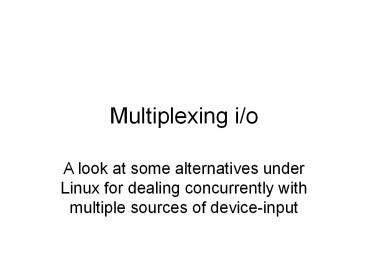Multiplexing i/o - PowerPoint PPT Presentation
Title:
Multiplexing i/o
Description:
(The fifth approach, while very interesting, seems to be unique to the Mach system) ... Any UNIX application can fork a number of child processes, each dedicated to ... – PowerPoint PPT presentation
Number of Views:49
Avg rating:3.0/5.0
Title: Multiplexing i/o
1
Multiplexing i/o
- A look at some alternatives under Linux for
dealing concurrently with multiple sources of
device-input
2
Whats the problem?
- Some applications need to process input from more
than one peripheral device - Input is normally obtained using a read()
operation on an open file-descriptor - But read() may cause a process to sleep if no
data is ready from a particular device - While asleep the process is unable to read new
data that is ready on any other device
3
Alternative approaches
- There are at least five possible ways for
overcoming this problem of deadlock - All of these approaches have been used, but some
have worked better than others - Four of these alternatives are supported by the
standard features of UNIX systems - (The fifth approach, while very interesting,
seems to be unique to the Mach system)
4
One immediate application
- We proposed the idea of a Linux program that
would utilize our recent knowledge of how to
program RealTeks 8139 network controllers in our
classrooms workstations - We want any pair of users who are sitting at
different computers to be able to chat by
typing messages in a window that will be visible
remotely in a different window - This requires multiplexed input (Project 2)
5
Method 1 timesharing
- Any UNIX application can fork a number of child
processes, each dedicated to reading data from
just one of the open device-files - The operating systems scheduler will then give
each process its opportunity to read and process
any new data that becomes available from its
particular device-file - But scheduling consumes CPU time, and any
task-coordination can add complexity
6
Method 2 non-blocking i/o
- UNIX applications can open device-files in a
non-blocking mode (if the driver allows) - Instead of sleeping when no data is ready, a
process can proceed immediately to try reading
from one of the other device-files - But this produces a CPU-bound program that can
starve other system applications (by constantly
calling read() for no data)
7
Method 3 using signals
- UNIX programs can install signal-handlers
- Then the application can sleep until it is
woken up by a signal that indicates new data can
be read from a specific device - Indeed this approach is widely used -- in cases
where the underlying device-driver implements the
required support-routines for so-called
asynchronous input-output
8
Method 4 using select()
- UNIX programs can invoke a convenient
library-function, called select(), which lets
the process sleep until at least one of the
device-files of interest is ready for reading new
data (or for writing new data), or until a
predetermined timeout has expired - This approach is favored because it enjoys even
greater efficiency and flexibility, not to
mention simplicity, than using signals
9
Method 5 multiplexed-read
- This method is the most efficient of all, as it
needs only one system-call, in blocking mode,
to be sure of obtaining new data from at least
one device in a specified set - Its programming syntax is not (yet) part of the
POSIX (Portable Operating Systems) standard its
not implemented in Linux
10
Using Method 4
- To support use of the select() function, a
character-mode device-driver needs only to
implement a poll() driver-method - It is very straightforward to do this review
Chapter 6 of Linux Device Drivers (3Ed) - We do it for our RealTek driver withpoll.c
- Our trychat.cpp demo-program uses the services
of this withpoll.c device-driver
11
The fd_set object
- Header-file include ltsys/select.hgt
- Declare fd_set readset
- Initialize FD_ZERO( readset )
- Setup for use FD_SET( nic, readset )
- FD_SET( kb, readset )
- Use int m 1 ( ( kb lt nic ) ? nic
kb - if ( select( m, readset, 0, 0, 0 ) lt 0 ) break
- if ( FD_ISSET( kb, readset ) read_kb()
- if ( FD_ISSET( nic, readset ) read_nic()
12
In-class exercise
- Try your hand at implementing Method 1 (the
timeshare method) for a version of nicchat.cpp
that does not require poll() - You can use our earlier rxplustx.c driver
- You can replace the select() function-call with
a fork() function-call, letting the child-
process read from standard-input while the
parent-process reads from /dev/nic.






























